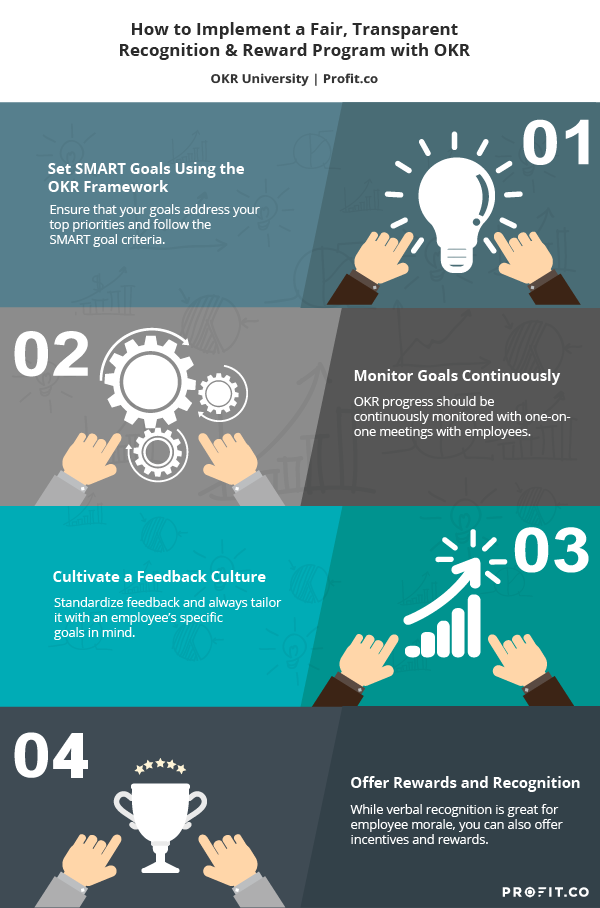Companies can use many methods to help foster employee engagement and maintain a high performance culture. Increased employee engagement has been directly linked to higher job satisfaction and productivity.
Two of these frameworks include OKRs and CFR. Objective key results (OKR) and conversations, feedback, and recognition (CFR) can work together to boost employee engagement and morale.
While OKRs should not be used to inform performance reviews, they can both affect employee engagement. Both OKRs and CFR can use a continuous performance management framework to help your team grow and develop.
In this post, we’ll discuss how you can use CFR and OKRs for rewards and recognition to create a positive workplace.
To win in the marketplace you must first win in the workplace.
Importance of Conversations, Feedback, and Rewards (CFR)
CFR stands for conversations, feedback, and recognition:
- Conversation: A meaningful exchange between manager and employee that focuses on driving performance.
- Feedback: Communication that flows up and down and across teams, which centers around evaluating progress and guiding future improvement.
- Recognition: Acknowledging the effort, skills, and talent of an employee.
According to John Doerr, author of Measure What Matters, CFR is a “delivery system” for your OKR. He states that CFRs “give OKRs their human voice”. CFR can serve as “fuel” for your OKR program.
As employees receive continuous feedback and recognition for their accomplishments, they often perform better at their jobs and feel more involved with the company. This can have a number of positive effects within the company, including boosting employee engagement, reducing employee turnover, fostering healthy superior-subordinate relationships, and driving employee growth and development.

Want an intuitive and agile framework to help you manage OKRs and employee engagement?

How OKR and CFR Work Together
In his book, Doerr stresses that organizations should use CFRs and OKRs to “capture the full richness and power of [Andy] Grove’s innovative methodology”.
If you’re using the OKR and employee engagement methodology, you’re likely setting specific, measurable goals. But you’re probably not integrating them into your performance management process. instead, they just become to-do list items, instead of guiding forces.
If this sounds like your organization, you can use a CFR strategy to get things back on track. CFR can make your goals more “human” and bring them to life through continuous conversation and feedback. This will give your employees the opportunity to connect with you as well as other teammates, as well as become more engaged with their work.
OKR Examples for CFR
Below are some examples of conversations you can start, feedback you can share, and recognition (CFR) you can give so that your employees can hold them accountable for their OKRs.
Conversation Starters:
- “Last week you mentioned that you felt stuck increasing your individual sales by 10% (KR). How is that going for you? Did you try the strategy we discussed?”.
- “I know that you wanted to increase brand awareness for the company (KR). And you aimed to do that by increasing website traffic by 20%. Let’s look at the marketing analytics to see if you met your goal.”
Feedback Examples:
- “For this quarter, we talked about increasing your win rate from 13% to 17%. To do this, you wanted to focus more time on nurturing leads through the funnel. But looking at your numbers, they still seem stagnant. Perhaps you need a bit more time. Or maybe you can try another strategy to increase win rate. What do you think?”
Sample Recognition:
- “Last time we met, you mentioned that you wanted to get training to improve your negotiating skills by the end of the third quarter. So far, it looks like you’ve done a great job attaining this goal as your close rate has improved significantly.”
Implementing a Fair, Transparent Recognition & Reward Program with OKR
Employee recognition is a key aspect of keeping employees engaged and motivated. While many managers want to recognize employee accomplishments, a lot of them aren’t sure how best to approach it.

That’s where OKR and CFR come in– to help you set measurable goals, provide goal attainment feedback, and offer recognition and rewards for goal completion. Additionally, the OKR or CFR framework can help you build an employee recognition and reward program for your organization. Instituting these programs in your organization can help standardize feedback and promote more employee involvement and engagement in work in the long term throughout the entire company, rather than just in a specific team or department.
Here’s how you can use OKR and CFR to build an employee recognition and reward program for your organization:
1. Set SMART goals using the OKR framework
Set goals you can measure. In order to write ambitious objectives and well-structured key results, you can use SMART goals. This is an acronym that stands for specific, measurement, achievable, realistic, and time-bound. Once you have created these goals, align them with department goals as well as organizational goals. For example, when it comes to OKRs and employee onboarding or OKRs and new employees, you can set goals to acclimate them to the company. These goals might include building higher satisfaction rates or achieving lower attrition.
2. Monitor goals
OKRs for rewards and recognition should never be a set-it-and-forget-it strategy. It’s vital to monitor the performance of your employees by holding one-on-one sessions. You can use key results to understand and track an employee’s progress on a particular goal.
3. Cultivate a feedback culture
Tracking the progress of employees is paramount. But it isn’t enough to ensure long-term growth and development. Whether a team member is doing well or needs improvement, provide feedback to guide them toward completing their goals. This also encourages them to give their best and stay productive.
4. Offer rewards and recognition
Regular feedback sessions are great for building engagement and meaningful relationships with your employees. But you can take things a step further by recognizing their accomplishments with rewards. For example, gamification, publicly praising employees, and even personalized thank you notes can go a long way in making employees feel appreciated and like their contribution means something.
To make your life easier, you can use an employee rewards and recognition platform. Doing so can not only help you enhance your company culture, but it can also offer employee rewards that recognize their contributions and incentivize them to keep being great.
For an all-in-one software to help you measure OKRs and encourage employee engagement, look no further than Profit.co! Book a free demo with our OKR experts today.
Ready to start your OKR Journey for FREE?

